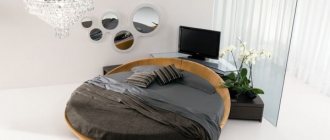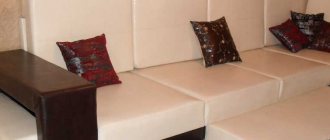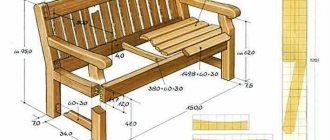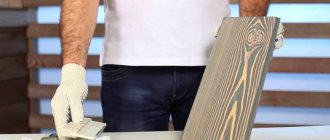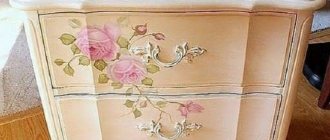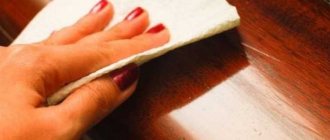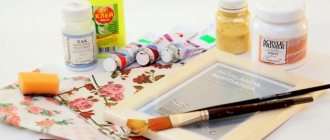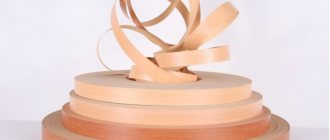As often happens, we received the technology related to the production and use of MDF boards from the USA. The North American continent often supplies Europe with new technologies, most of which are truly useful and remain for a long time in various industries and fields.
Painting MDF began to be used overseas several decades ago, and in Russia this technique is just spreading.
The coloring of MDF boards is determined by the format of use of this material. Thus, MDF is virtually never used for external work. This material is not sufficiently resistant to moisture and temperature changes. In addition, MDF's strength and ability to withstand pressure also leave much to be desired. Finally, compared to some other materials, MDF panels are quite expensive to be used for facade cladding.
But the use of MDF boards indoors is quite extensive. Today, such slabs form the basis for wall decoration and the production of a wide variety of furniture (mainly cabinet furniture). Accordingly, painting of MDF panels always takes place indoors.
Types of paints for MDF boards
Let us immediately note that below we will talk about paints that are best suited for MDF furniture. However, painting MDF facades will be based in any case on the same principles - with minor adjustments to the specifics of the shape and surface.
As for the dyes themselves, they should be chosen not based on the brand or manufacturer (although, of course, this aspect also has a certain significance). However, it is much more important to pay attention to the features of a particular paint - application format, drying speed, composition, manufacturing method.
In addition, different cases may require different paint for MDF.
The following factors play a role:
- MDF size and shape;
- terms of use of the product;
- preferences in terms of design and aesthetics;
- question of cost.
Let's look at the main types of dyes for furniture facades made of MDF boards.
Water based dyes
These are the most simple, affordable and easy-to-use formulations. They are ideal for painting a large MDF surface quickly and with a sufficient level of quality.
The most important feature is the environmental safety of the paint and the absence of a suffocating unpleasant odor. This is great when it comes to painting indoors, even if it is unventilated. Water-based dyes are considered neutral for human and animal health.
From an aesthetic point of view, this type of paint for MDF also has room to roam. Most manufacturers offer both classic white paints and a wide range of colors.
Water-based dyes are those that can be used not only indoors, but also for outdoor painting.
Silicone dyes
Ideal for eliminating moisture problems and even water ingress. Silicone repels water and is resistant to high temperatures, as well as temperature changes.
If the room is periodically either very warm or very cold, the MDF boards will inevitably begin to slightly deform and periodically expand and contract. This imposes certain requirements on the paint - it must be able to elastically adjust (primarily, stretch) to changes in the shape and area of the MDF board.
A product painted with this composition is easy to clean. However, dust does not linger very actively on silicone, so the cleaning process happens quite rarely. MDF painted with silicone copes with this task perfectly and has no competitors in this aspect.
Acrylic silicone dyes
This is a mixed, borderline option between the first two types of paint. On the one hand, such dyes are environmentally friendly, safe, and have a mild odor. On the other hand, they are resistant to temperature, moisture and even mechanical influences.
Painting furniture parts made of MDF with such compositions protects it from wood bugs (relevant, for example, for garden furniture), drying out, mold and mildew, as well as any other microflora.
Polyvinyl acetate dyes
In this case, the main advantage of the coloring composition is its cost. If specific characteristics and specifics of paint application do not matter to you, then this is an ideal option.
It is believed that polyvinyl acetate-based paints are suitable for products and premises with minimal external influence. If the risk of mechanical stress, high temperature, excessive humidity, etc. is too large, it is better to give preference to other compositions. If there are no risks, then you can make a choice in favor of such paint.
Separately, it should be mentioned the need to correctly follow the stages of applying paint to MDF boards. Each manufacturer specifies its own requirements, and technologies often differ significantly from each other. That is why it is important to pay attention to the recommendations on the packaging and consult with the seller at the time of purchase.
The main danger when violating the dye application methodology is the possibility of peeling. In this case, the paint exists as if by itself in relation to the surface of the panel. A layer of air appears between the hardened paint and the product itself, and over time this leads to the deposition of dried dye.
Oil based dyes
Allows you to achieve the most aesthetically attractive effect. If the application technology is followed, the surface becomes smooth and glossy.
However, in addition to purely aesthetic characteristics, oil paints serve as excellent protection against moisture. In this sense, they could compete with silicone, if not for their low mechanical resistance.
A circumstance that requires additional mention in the context of painting furniture facades with oil compositions is adhesion, that is, the adhesion of the paint and the material itself. Getting the oil compound to adhere naturally to the MDF panel is not so easy. For maximum adhesion, it is better to use a primer. It must be applied to a dry and clean surface before painting.
Alkyd dyes
Here again we observe the property of elasticity, flexibility of the material, and ability to stretch, which is so useful for MDF. Alkyd enamels also form a noble, uniform surface with a matte sheen.
Acrylic paint for MDF facades is ideal when it comes to a working surface. Acrylic does not rub at all, does not pill, does not change color with repeated friction and is even resistant to chips.
The only negative quality of this type of dyes is their instability to heat and direct sunlight. This exposure causes fading very quickly, which is especially noticeable if colored paint was used.
Regardless of what type of paint was chosen, it is better to calculate the required quantity in advance so as not to make mistakes when purchasing. Please note that the consumption of different coloring compositions differs - some of them are more economical, others, respectively, less. Paint consumption per square meter of MDF paint manufacturers indicate packaging. Plus, this data is most often known to the seller.
It is always recommended to purchase paint with some reserve. This will allow you to safely cover the surface of the furniture façade with an additional layer, correct defects in painting and, in general, not be afraid to carry out high-quality painting.
The same goes for purchasing a primer to ensure adhesion. There is no point in skimping on primer - this almost always leads to rapid peeling of the paint, damaging the appearance and properties of the MDF panel. As a result, you will soon have to remove the layer of old paint and correct the situation. Thus, the paint consumption will be double.
Conclusion
Painting MDF can significantly increase its service life, as well as make the product more attractive and resistant to elevated temperatures. Since MDF is a wood material, it can be treated with almost any paints or varnishes for wood (see also the article “Painting MDF furniture facades”).
But to get the best results, you should still use specialized compounds. This is a polyurethane primer, as well as polyurethane enamel and varnish on MDF. They allow you to create a hard and wear-resistant coating that can have a wide variety of colors.
The video in this article will give you more information on this topic.
Types of varnishes for MDF panels
In some cases, MDF wall panels are not painted, but varnished. This approach is very widespread, although it is considered more complex and expensive.
Lacquered panels certainly look very noble and attractive. Varnishing allows you to emphasize the natural shade of the material, give it shine and pleasant smoothness.
Applying varnish to MDF is a painstaking process that requires care, accuracy and certain knowledge regarding the specifics of the technique. Varnishing occurs differently in open and closed spaces, and the process is modified in accordance with the potential format of use of the product.
In total, there are eight traditional types of varnish coating for MDF boards. Let us describe each of these varieties in more detail.
- Alcohol varnish
To create the desired consistency, special thick resins of artificial origin are mixed with industrial alcohol. Such varnishes are inexpensive and are considered average in quality. As for the drying process, on average it will not take more than half an hour, although to achieve a guaranteed result it is recommended to allocate up to 1 hour for drying. Much will depend on how many layers and in what humidity the alcohol varnish was applied.
- Epoxy varnish
It contains two components that provide maximum protection against mechanical damage. This coating increases the strength of the MDF panel several times, and is therefore perfect for painting countertops. In addition to impact resistance, epoxy mixtures also guarantee protection against the influence of moisture and even water flows on the product. Accordingly, this varnish can be used for garden furniture made from MDF sheets.
- Alkyd-urea varnish
The composition is again formed by two main ingredients - alkyd resins and urea. But in this case, a fixing element (hardener) is added to the mixture.
The main features of alkyd-urea coating are high strength and maximum light reflection. The latter property allows you to achieve a luxurious shine to the varnished surface.
- Nitrocellulose varnish
Once again, the name of the varnish reflects its basic composition. Varnishing with such a product allows you to achieve sufficient moisture resistance, but you can’t really count on protection from mechanical damage. The cost is considered quite reasonable, so if protection against impacts on the surface is not a critical aspect, this option can be considered a compromise solution.
- Polyester varnish
The composition in this case includes many different components, the main one of which is polyester resin.
The best option for situations where it is important to protect an MDF product from chemical exposure. In medical institutions and chemical laboratories, such varnishing is almost the only solution for MDF furniture.
In addition to resistance to chemicals, polyester varnishes are also resistant to overheating - they do not melt, crack, become cloudy or deform.
- Acrylic urethane varnish
The safest water-based composition. It is considered environmentally neutral and does not harm health.
At the same time, due to the peculiarities of the composition, acrylic-urethane varnish adheres perfectly to the surface of the MDF panel and dries quickly.
It is resistant to moisture (not water flows!) and changes in ambient temperature.
- Polyurethane varnish
It can be presented in one of three different variations - with one, two or three components in the composition.
This varnish takes as long as possible to dry. Sometimes the process can drag on for up to a week or two, but the end result is the hardest possible coating, which is almost impossible to damage in any way. Highest strength, aesthetic appearance and perfect adhesion. It is virtually impossible to separate the polyurethane varnish from the surface after it has completely dried - it literally becomes part of the MDF surface.
- Acrylic lacquer
Another safe option for health with minimal toxicity. Acrylic compounds can even be inhaled without much risk or discomfort. Moreover, acrylic varnish has no effect even on food with direct, long-term contact. This makes it possible to varnish furniture for kitchens and catering areas with acrylic.
Such varnishes can be diluted with clean water to achieve the desired consistency. As a result, the coating is more or less dense. The degree of transparency of the varnish and its strength can be controlled accordingly. In general, acrylic varnish occupies a middle position in its performance characteristics and stands out only for its environmental friendliness.
How to paint and renew MDF panels
For MDF panels, you can use alkyd or acrylic enamel, but when choosing a paint, you should take into account the type of primer, operating conditions of the panels, and the composition of the top layer. If it is laminated paper with a synthetic, weakly absorbent film, then it would be advisable to use acrylic or water-dispersion enamel. These materials are environmentally friendly and are perfect for interior painting indoors, while the surface of the panel will be renewed and also additionally protected from the moisture of an aggressive external environment.
Thus, if the entire painting technology is followed, the question of whether it is possible to paint MDF panels becomes completely solvable at home.
The process of painting MDF furniture
You should not start painting without experience. It is better to practice painting individual neutral areas to develop general skills and understand the technique. It is most likely impossible to thoroughly understand how to paint MDF without practice.
The main tools for applying the coloring composition are a special spray gun or brushes. If the choice falls on brushes, then it is better to give preference to the softest ones possible, preferably with strong and flexible bristles.
It is important to think through the process of drying the painted product in advance - there should be enough space, and the room should be ventilated, with a temperature of about +20 degrees or more. Only in this case will the paint actually lie as expected.
The main stages of painting MDF facades:
Stage 1. Prepare the MDF surface.
At the first stage, it is necessary to thoroughly clean the panel to be painted. Traditionally, you will need to degrease, remove contaminants - dust, debris, and also dry the MDF board. Separately, it is necessary to mention sanding - this is a mandatory step, which is necessary for maximum adhesion of the paint to the surface.
By the way, for large-scale work, it is much more expedient not to manually clean every 10 cm of surface, but to use automatic devices - a grinding machine or similar units. It is important to take safety precautions when sanding. For example, in order to avoid hewn particles of the MDF surface from getting into the respiratory tract, it is worth working in a respirator. By the way, it will also be useful during the process of painting or varnishing - the smell in this case can be quite pungent.
Stage 2. Elimination of the consequences of grinding.
As already mentioned, during the cleaning process a lot of small particles appear that cannot be wiped off the MDF sheet with one movement of a rag. This is where vacuum cleaners, compressors, or at least thick brushes come to the rescue.
When all the debris has been removed, it is worth checking the surface for smoothness. If there are protruding particles, they will have to be removed separately.
Stage 3. Applying primer.
A primer is not always necessary, but it is definitely never superfluous. In other words, if we are not talking about oil paint, then you can do without a primer, although its presence will be beneficial in any case.
Ideally, two different compositions should be used for the primer, which are applied sequentially one after another. First you need to wait for the first layer to dry before applying the second. The main condition here is to avoid excessive accumulations of primer in certain places. Such “puddles” will eventually form unevenness and interfere with accurate, high-quality and uniform painting.
Preliminary calculation of the primer is made according to the principle of 100 g of composition per square meter of MDF surface.
Using brushes to apply primer is not the best solution, because the fluff will leave marks anyway, and the point of primer is to make the surface smooth.
In terms of application, attention should first be paid to the sides and ends of the product, and only then move on to the main area.
Stage 4. Cleaning the primer.
Here you will no longer need sandpaper, but softer materials. For example, a thick sponge or washcloth is ideal. There are special construction sponges designed just for such purposes.
The most important thing here is to ensure that the surface becomes as uniform as possible, without receiving mechanical damage in the form of scratches, even the smallest ones.
Stage 5. Re-dust removal.
We repeat stage 2 - use a vacuum cleaner or hairdryer to remove small particles formed when cleaning the soil.
Stage 6: Re-priming.
This stage is additional and is not always used. The main task of re-priming is to achieve the most uniform, dense surface and at the same time a more dense, rich color when painting MDF boards. In addition, due to the thickening of the surface, the strength of the product increases.
Stage 7. Preparation of the coloring composition.
What exactly will be done at this stage directly depends on the characteristics of the chosen paint. We recommend that you always carefully study the packaging, consult with sellers and visit the websites of manufacturers of certain formulations.
Stage 8. Direct staining.
If you use a brush, then it is better to take a composition that is thicker than what would be suitable for a sprayer. At the same time, the sprayer certainly gives a more uniform, predictable result when painting.
The ideal option is two layers of paint applied in different directions.
If we talk about calculating the consumption of the coloring composition, then on average about 80-150 g are allocated per square meter.
Stage 9. Varnishing.
A completely optional step in some cases and inevitable in other cases. Painting of furniture facades must be completed with varnishing. Only in this case can the durability and attractive appearance of the product be achieved.
Technology of painting MDF with enamel.
The two most popular methods of covering facades. Firstly, this is painting MDF with enamel. Secondly, film coating. In this article we will look at the first method. Let’s make a reservation right away: this type of painting is for industrial conditions. High-quality glossy painting of MDF at home is very difficult.
Here we provide a short description of the technology used to paint MDF with enamel. The production process can take up to 10 days.
Preparatory stage.
- First, the surface is primed with an insulator. This is done in order to avoid raising the pile during subsequent sanding. It also prevents the enamel from sagging and being absorbed into the surface.
- After the first layer of primer has dried, use a sander to sand carefully so as not to damage the thin layer of primer.
- Next, a second primer is applied. White polyurethane painted MDF. This layer is needed for accurate color rendering. This layer dries up to a day.
- And again sanding. Using a sander with a P320-400 grit disc. Hard-to-reach areas are sanded by hand. After the first grinding, perform a second pass with a P400 wheel. This is done to achieve the best final result.
- If necessary, all chips and defects are filled with a one-component compound.
Application of enamel.
- Then the enamel is applied. Starting from the edge, moving to the main plane. An important point - professionals use only an industrial spray gun in their work. They apply both primer and enamel.
- It is impossible to achieve a high-quality result with a brush. On the Internet you can find tips on painting MDF with enamel using a spray can. We recommend using a spray gun. It is very important that the enamel application process takes place in a special room. Because dust, insects and tiny particles of dust can ruin the entire work.
- MDF painting is finished. Now apply varnish. Acrylic clear varnish is applied in two layers. The first layer dries - apply the second.
Finishing the product.
- Next, the façade is finally sanded, sprayed with water for cooling. Start with a grit of P1200-1500, gradually reaching a finish of P3000-4000. It would seem that only the final finishing of the product remains, but at this stage of painting MDF with enamel, the surfaces are uniformly matte.
- Polishing is the final stage of work, during which that magical glossy effect is achieved. Before polishing, the product is thoroughly dried. Depending on the specific materials on which the work was performed, after painting the facades dry for about two days. After final sanding, drying takes 5-7 days.
- The grinding machine at low speed applies abrasive paste to the entire surface of the product. And at high speeds, the actual polishing is carried out. First horizontally, then vertically. The result is a bright glossy effect.
- That's all! The product is packaged in foamed polyethylene and corrugated cardboard. These are “breathable” materials that allow chemical vapors to escape, which will continue to escape from the product for some time.
Please note that some unscrupulous companies use auto enamel for kitchen facades, claiming that it will be more beautiful. Painting MDF in the kitchen should be carried out only with specialized paint and varnish materials. Because they are safe and intended for direct contact with products!
Now you know what technology is used for glossy painting of MDF. We think that no one doubts that it is better to entrust this rather complex technological process to professionals. Call: +7 985 211 99 96 we will carry out painting of any complexity in compliance with all technologies.
MDF varnishing process. Video.
It has already been said that applying varnish to painted MDF is not an easy task, requiring some skills and great care. Moreover, it has long been noted that higher-quality varnishes are applied more easily and dry more easily than low-grade, cheap alternatives.
By analogy with painting, we will divide the process of coating the surface of furniture with varnish into successive stages.
Stage 1. Preparing the varnish.
It is necessary to dilute or simply pour the varnish into a container from which it will be convenient to apply it to the product.
Stage 2. Application.
The ends and protruding parts are varnished first, then you can move on to flat surfaces. This is a universal approach that works with all products.
Stage 3. Cleaning.
It is recommended to carefully treat the dried first layer of varnish with a special abrasive material. In specialized stores you can buy special fiber for wiping varnished surfaces. In other cases, you can use a sponge or washcloth again.
To perform better, you can moisten the varnish with water. This solution will prevent dust from rising and at the same time make it possible to clearly monitor the smoothness of the varnish.
Grinding is one of the most labor-intensive and time-consuming processes.
Stage 4. Getting rid of dust.
Once again, the cleaning should be completed by removing the remaining small particles. Sanding may result in more or less debris - this has to be controlled on an individual basis. The effectiveness of cleaning is checked visually.
Stage 5. Polishing the varnished product.
Neglecting polishing is a big mistake, leading to clouding of the varnished product and other damage.
The process will require a special construction wheel and polishing paste. Without these two tools, it will be impossible to implement the polishing stage. The polishing paste is applied to the circle in approximately a millimeter layer. Next, the paste is distributed by rotating the circle and rubbed into the surface of the MDF.
Additional polishing can be provided with separate reflective compounds.
How to remove old coating from MDF board
Often, in the context of MDF, the more pressing task is not the task of new staining, but the task of eliminating the consequences of the previous one. This applies to both unsuccessful painting or varnishing and the influence of time. Paint for MDF facades usually comes off extremely reluctantly and, as practice shows, even if there are defects, it can be quite difficult to clean the entire surface.
There are several ways to remove paintwork from MDF:
- Mechanical. In this case, simple scraping of paint or varnish is used with a spatula, a drill attachment in the form of a metal brush, or a grinder. This is an extremely labor-intensive and rather dirty process.
- Temperature. The idea is to heat the surface. A hair dryer will allow you to reach the desired temperature. As a result, the varnish or paint softens and will come off much easier; sometimes it is possible to remove the painted layer like the skin of a banana.
- Chemical. The task again is to soften the paintwork. This is only achieved through special solvents, which must be applied to the surface and covered with polyethylene for a while.
Painted MDF furniture facades have been the best solution for many decades and allow you to revive almost any product. Moreover, it is high-quality painting and varnishing that can guarantee an item a long life and protection from obsolescence - both physical and moral.
Technological process
The most convenient way to paint is with a spray gun. If you don’t have one and you can’t purchase such a unit (or simply don’t want to), use a roller. The main thing is that the roller has short pile. As a last resort, you can paint it with a brush, also with fine bristles. When purchasing, consult with the seller which roller (brush) to purchase, depending on the coloring composition that you plan to use.
The vast majority of experienced painters prefer to use spray paints. But such a solution has both strengths and weaknesses. The undeniable advantages include uniform application of the paint and varnish composition and, as a result, an excellent final result.
The end result will definitely please you.
Well, the main disadvantage is that nearby objects are necessarily painted without your consent. In other words, this method is quite “dirty”, and in order to avoid serious losses, it is recommended to paint in a separate room that you don’t mind getting dirty.
A spray bottle will help in painting furniture.
Be sure to paint in one direction. Usually two layers are enough. The main rule: each subsequent layer is applied only after the previous one has completely dried.
Changing the facade yourself not only saves money, but also allows you to make it as intended.
And work should be performed at a temperature of at least 15 degrees Celsius. To avoid poisoning by fumes, as well as to avoid paint getting on your skin or eyes, you should always wear protective glasses and gloves when working.
Photo: how to remake old furniture.
If you notice a defect in a painted area, eliminate it, sand the surface and carefully repaint with a cotton swab using light blotting movements. If a speck is found on a freshly painted façade, remove it using a sharp object, such as a knife.
View of an old product after restoration.
Most often, after painting, polishing of the product is required. The surface must be absolutely dry, there should be no dust or small debris on it, since any lint will be very noticeable in the light. If you are varnishing in several layers, remember that the first one should be the thinnest, and subsequent ones should be applied only after the previous one has completely dried.
You can choose to cover it with paint or varnish, and also decorate the sample using scrap materials.
After varnishing, the surface is sanded again. First, coarse-grained paper is used for this, and then fine-grained paper. To prevent pellets from appearing, the working surface is periodically moistened with water. A week after painting, polishing and sanding, the product is sanded again using an abrasive paste.
Don't throw away old furniture.
So, tired of furniture? Don't throw it away. It’s better to think about what bright color you can repaint a familiar interior element. And take action!
Improve your room design!
Perhaps you will find the painting process not only practical, but also exciting, and you will be happy to color other pieces of furniture.

